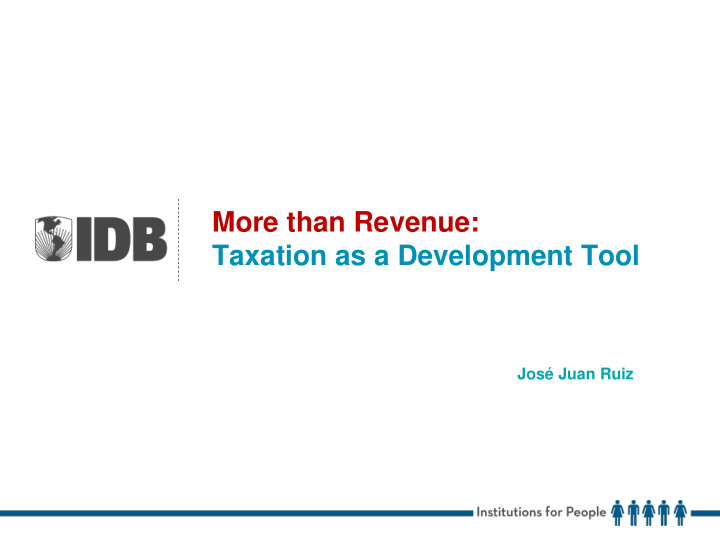



More than Revenue: Taxation as a Development Tool José Juan Ruiz
Improving Tax Institutions and Rules in LAC 1. 2007 San José Consultation: the biggest challenge and the biggest opportunity to advance economic and social progress in LAC 2. Recent growth of Tax Revenues in LAC has been the fastest in the world … but still a long way to go: • Most countries still far from exhausting their revenue potential • More than revenue: taxes has to be designed as tools for stimulating development
Contents The Tax Forest 1 Undressing the Myths 2 The Politics of Taxation 3 Tax Systems for a Smooth Ride 4 Beware of Informality 5 Local Taxes for Local Development 6 Making the Most of Tax Administration The Trees: Tax by Tax 7 Personal Income Tax: An Empty Shell 8 Corporate Income Tax: The Art of Competing for Investment and Increasing Revenue 9 Value Added Tax: Let It Be 10 Taxing Commodities with the Future in Mind 11 Protecting Goods by Taxing “ Bads ” 12 Heterodox Taxes: The Good, the Bad, and the Ugly Harvesting for Development 13 Growing a Reform Agenda
Pro development Tax system: Some Principles 1. Taxes that favors the Poor : A real and progressive Income Tax 2. Tax Systems simpler and with a broader base 3. Stronger Tax Administrations: Compliance 4. Ensure Local Governments have enough resources to act as agents of development 5. Tax system that look to the future: Natural resources and envinromental taxes.
The vicious triangle of the small firms Many small firms Low productivity Informality
Special regimes: Fiscal dwarfism without revenue Simplified Regimes: Maximum Income Limits 180 1.0 0.9 160 0.8 140 Revenue as a percent of GDP 0.7 120 (right axis) 0.6 100 0.5 80 0.4 60 0.3 40 0.2 20 0.1 0 0.0
Special regimes: Fiscal dwarfism without revenue Simplified Regimes: Maximum Income Limits 180 1.0 0.9 160 0.8 140 0.7 120 Revenue 0.6 100 (percentage of GDP, right axis) 0.5 80 0.4 60 0.3 40 0.2 20 0.1 0 0.0
…that creates sizable horizontal inequity
Obstacles to tax reform: Mainly political economy • Dependence on revenues from non-renewable natural resources , which discourages domestic revenue mobilization • Resistance of economically and politically powerful interest groups that benefit from tax concessions • Poor perception by the median voter of – The value of public goods and services – The link between revenues and the fiscal space for improving the provision of such goods and services – The effectiveness and fairness of the tax administration – The cost of tax expenditures – Soft budget constraints that discourage sub-national tax effort
How to overcome these obstacles? • Increased budget transparency and communication – Estimate and disseminate the distribution of costs and benefits of tax expenditures • Institutional reforms – Save part of resource revenues – Harden the sub-national budget constraint – Increase autonomy and transparency of tax administration
Generalized evasion in income taxes Tax Evasion Rates (percentage) Peru El Salvador Mexico Costa Rica Chile Argentina Dominican Rep. Ecuador Guatemala -10 10 30 50 70 Personal Income Tax Corporate Income Tax VAT
Minimum chances of being audited Invoice Controls, Mass Audits, and In-depth Audits, 2010 (Percent of active taxpayers inspected) Invoice In-depth Mass audits controls audits Argentina 1.7 1.6 0.4 Chile 5.9 14.8 0.2 Colombia 0.1 Costa Rica 0.3 0.1 Dominican Rep. 10.0 1.2 0.0 Ecuador 0.0 1.0 0.1 El Salvador 10.0 0.9 0.8 Guatemala 0.2 0.2 0.1 Mexico 0.1 0.2 Panama 0.1 2.0 0.0 Peru 4.2 3.6 0.2 Average 3.1 2.8 0.2
To collect taxes is essential, but not enough • Increase revenues – Reform personal income taxes – Strengthen subnational revenues (ej., property and green taxes) • Fight inequities – Reduce VAT regressivity with transfers to poor households – Gradually incorporate middle classes to personal income tax • Promote productivity – Eliminate exemptions, incorporate SMEs to general regimes – Dismantle distortionary heterodx taxes • Bet on the future – Tax “bads” (externalities from fuels, trash) – Prepare for when natural resources get exhausted
VAT reform options • Main recommendations – Eliminate pervasive exemptions – Unify rates – Use part of additional revenues to compensate poor households – Use the rest to reduce payroll taxes • These reforms would – Reduce informality – Improve productivity and external competitiveness – Facilitate tax administration – Not hurt the poor
Taxing “bads” to protect “goods” • Main recommendations – Focus excises on a few goods whose consumption is to be discouraged (notably alcohol and tobacco) – Strengthen environmentally-related taxes – Eliminate significant energy subsidies in some countries – Consider the introduction of taxes on carbon emissions • Such reforms would – Mobilize revenue – Promote efficiency in the use of scarce resources – Improve vertical equity
Local taxes for local development • Sub-national governments in LAC have limited sources of own revenues (except states in Brazil), hampering political accountability, fiscal responsibility, and improved provision of goods and services • Potential new sub-national tax handles – Regional income tax (or surcharge on national income tax) – Regional VAT (Problem: complexity of taxing interstate trade) – Regional or local excise taxes (or surcharge on national excises) • Better utilization of existing sub-national revenues – Property taxes (with improvements in property cadasters) – User fees – Tax administration
Phasing out “heterodox taxes” • Main recommendations – Eliminate financial transactions and export taxes – Progressively reduce presumptive tax regimes (including special regimes for SMEs), as tax administration improves • Such reforms would improve efficiency, including by reducing disincentives for SMEs to outgrow special regimes • They would need to be combined with other recommended reforms to offset potential revenue losses
Recommend
More recommend